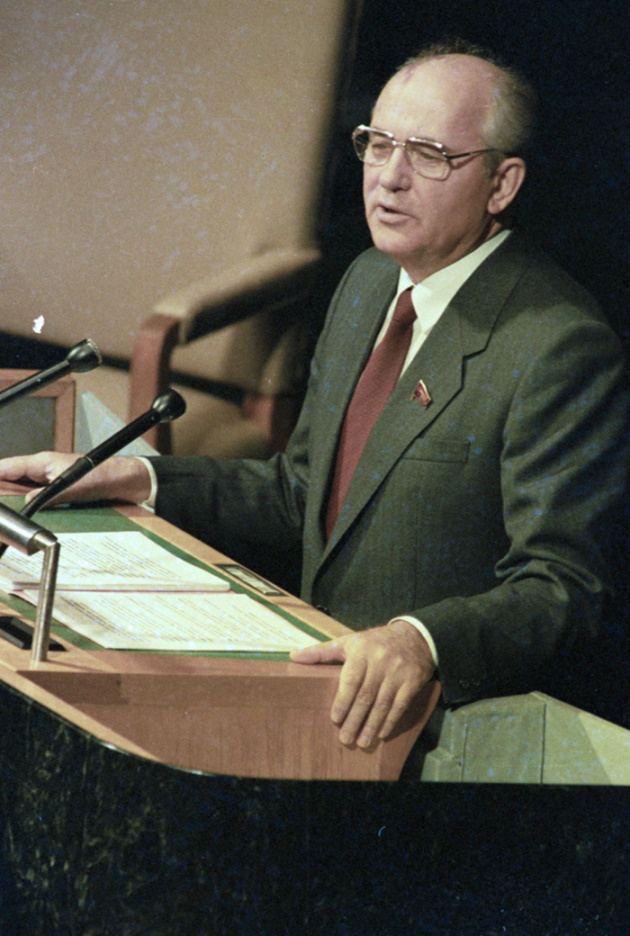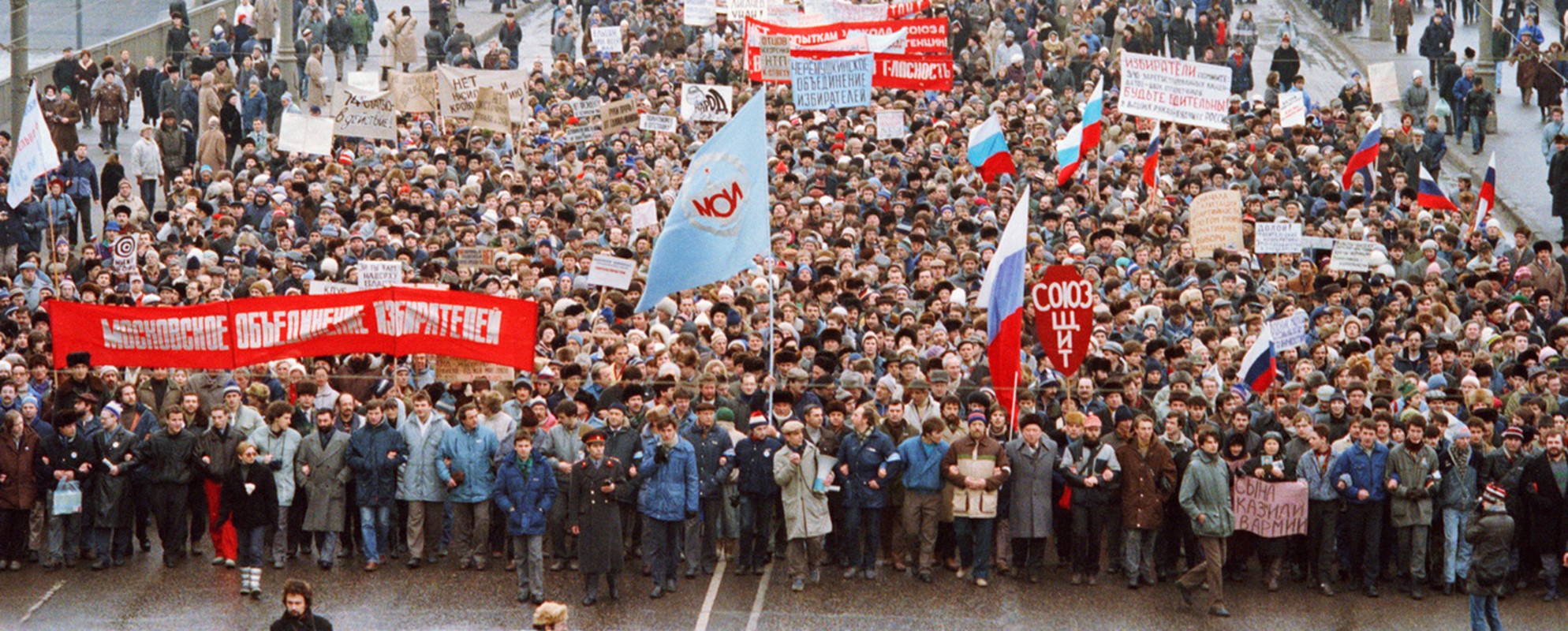

Table of Contents
The USSR has been unarguably one of the most significant factors of the 20th century, leaving a substantial mark on world history. It was one of two world superpowers and a leader of the communist bloc in the Cold War, without mentioning other various aspects and contributions to science, culture, technology, etc. Often depicted as a “world’s bad guy” and dubbed the Red Giant as a menacing figure indicating its leading ideology, most of the world thought the Soviet Union was a strong and stable nation that would endure for a long time. Thus, when in December of 1991 it dissolved, many were left in astonishment. That left a burning question – why did the USSR collapse if it was that powerful?
Political and national fracturing
Reforms and liberalization
The most common starting point for the story of the dissolution of the Soviet Union is 1985 and Gorbachev’s ascension as the Party Secretary. As a 54-year-old, he was one of the youngest and it seemed most liberal leaders of the USSR at the time. Upon gaining control over the union, he immediately swore to reform it. Gorbachev’s goal wasn’t to dismantle the communist regime and in turn, topple the Soviet Union, but rather to invigorate it, especially its struggling economy. To achieve such goals, he committed to programs like Perestroika and Glasnost. First introduced market liberalizations, though still maintaining some sort of planned economy, while the latter brought the ideas of governmental transparency and free speech into the Soviet political life. Despite what Gorbachev planned, such liberal ideas quickly ran loose, like a snowball, pushing for further reforms and restructuring, as people demanded more and more freedom. By 1989, the USSR held its first multiple-choice elections across various levels of government.

Mikhail Gorbachev addressing the United Nations in 1988.
The results exposed the cracks in the party control. In early 1990, the Communist Party of the Soviet Union (CPSU) decided to cede its political monopoly, allowing fully competitive and democratic elections in all the republics. As a result, it lost power in 6 out of 15 republics. The periphery began to split away from the union, while the party even had troubles mainlining power in Russia and Moscow, unarguably the heart of the USSR. Overall, Gorbachev’s reforms slowly dismantled the system put in place by Stalin, allowing for cracks in the unity of the nation to spread. This was largely unintentional, at least at first. Yet such loosening only uncovered all the corrosion the Soviet system accumulated over time.
Awakening of nationalism
One of the most erosive forces in the Soviet Union proved to be one which it once bragged about – its multiethnicity. When the union was being forged in the fire of 1917, it encompassed several different ethnic groups, with the major one being given their republics. At that point, this was seen as liberation from the oppressive regime of the Russian monarchy, as all the constituent nations were given the right to foster their own culture and language. Yet, over time, those liberties started to fade. The party began propagating a more unitary culture based on communist ideals, at a certain point stifling the individual identities of certain nations. Coupled with that was the undeniable dominance of Russian ethnicity, which became the basis of the Soviet communist society. This was partially a result of the simple fact that the Russians were indeed the majority in the USSR, but also because they usually held the highest positions in the party and the state.
Thus, when the relaxation of central party control loosened the restraints, numerous nationalist associations and groups started popping out, seeking more and more independence from Moscow. After all, it was the nationalist parties that toppled the party in the 1990 elections across the Soviet republics. Here it is vital to mention that not all nations shared the same levels of disillusion with the party and the union. Even today some Central Asian states claim the 60s and 70s were their golden age, while the Baltic states sometimes equate German fascist occupation with the Soviet regime. Nevertheless, it seems that the USSR never managed to diffuse nationalism, only hide it with its propaganda and iron-tight rule. As the quality of life in the Soviet Union deteriorated, the nationalist tension simply began to bubble once again.
Economic failure and military overexpansion
From a socialist utopia to a third world economy
This leads to yet another issue, the economic decline of the Soviet Union. Over its roughly 80-year long history, the USSR managed to go through two economic booms, one in the 1930s and then with another in the late 50s and early 60s. With state-backed industrialization, the CPSU transformed what was once an agrarian monarchy into an industrial giant second only to the US. However, in the 1970s its economy entered a period of stagnation which only worsened in the 1980s, swaying Gorbachev towards the aforementioned reforms. One of the reasons for slow decay was in the rigidity and bureaucracy of the Soviet economic system. The centralized economy was slowly killing incentives among the workers and farmers, while the technological innovations were tough to implement. The economy was only further burdened by the political desires and needs of factory managers and party leaders. In the end, it was more important to have good reports than actual good results. With that, not only was the overall production dwindling but the quality as well. All the while, the USSR began to seriously lag behind the US.
The rigidity of the system also made it rather unable to react to current needs. Initially, the Soviet Union managed to hide its growing economic problems with oil exports, making great use of rising prices of the early 70s. Yet, when the prices began dropping in the 1980s, it was a hard blow on the economy. Making matters worse, Soviet agriculture suffered from severe droughts for several consecutive years from 1979 to 1986. This meant the union had to import more and more food, while its exports were falling, especially as its consumer products began to lose quality without technological advancement. Disaster in Chernobyl in early 1986 only added a further strain on the economy of the USSR, as ecological cleanup and relocation of people required millions of rubles.
Overall, as the Soviet economy was slowing down due to various reasons, its inflexible ideological and bureaucratic system prevented any significant changes to restart it, leading the nation into poverty.
Military above everything
Adding another burden to the economy, the CPSU maintained a policy that the military mustn’t suffer. There was a constant need to boost its fighting potential, partly due to fear from armed conflict with the US, but also to project an image of a superpower. Thus, throughout the Cold War, the USSR spent a whopping 10 to 20 percent of its annual budget on the military. In comparison, the US peaked at 9.4% (1967), while the world average continued to drop from about 6.2% in the 60s to 3.4% in 1989. Such expenditure was unreasonably high, further crippling the economy. The military sector was also sucking up most funding for technological development, which often had little common or economic use. On top of that, to maintain its status as a global power, it had to send quite expensive military aid to numerous nations worldwide.

Soviet troops in Afghanistan. Source
If that wasn’t enough of an encumbrance for the already troubled and weakened Soviet Union, its leaders decided to get militarily involved in Afghanistan in 1979. Similarly, to the US in Vietnam, they got involved in what was more or less a civil war to support a communist regime loyal to Moscow. It was supposed to be a quick intervention, over in a matter of months, but instead, the Red Army faced stiff guerilla opposition from mujaheddin who were backed by the US. Thus, they were bogged in what was essentially a useless war, costing them even more money, resources, and not the least people. In the end, the Soviets retreated without winning, damaging their image and status. The USSR gambled and lost, adding yet another crack in its unity.
External factors and loss of faith
Transformation of the world
Such high military expenditures weren’t only caused by the Soviet need to prove their worth but were also actively instigated by the US. While in the early days of the Cold War this was a byproduct of the struggle for world dominance, in the 80s it was an active American doctrine. It was done to exert more pressure on a system that was already showing signs of weakness. Moreover, it came after a brief period of so-called détente, when two superpowers seemed on a path of reconciliation of sorts. This increased US challenge to the Soviets as a cause of the dissolution of the union is sometimes exaggerated by western historians, yet it undeniably played its role. However, rekindling the chillness of the Cold War wasn’t the only wave of change that brought the USSR to its knees.
More destructible was the fact that its allies and satellite states began crumbling as well. Like a ripple effect, the economic crisis in the USSR affected its bloc. With that, the puppet communist nations in East European countries saw a rise in dissatisfaction, protests, demanding reforms, and liberalizations. Weakened by its own troubles, the Soviets were unable to help their allies secure their rule like they did in [Hungary (1956)]/(post/the-hungarian-revolution-of-1956-failure-of-both-east-and-east/) or Czechoslovakia (1968). The wave of resentment against the communist reign swept the Soviet bloc, eventually spilling into the USSR as well. Directly or indirectly, those helped steer Gorbachev’s reforms, pushing them probably further than he initially planned.
Erosion of ideology
Finally, this brings us to the point of social change and disillusionment of the Soviet public. The USSR of the 1980s was a much different society than in the 1920s or 1950s, more urbanized and educated, with grander appetites than before. Furthermore, they were promised a better life than before, with ideas of a utopian society. Instead, they were faced with economic decline, a rise in corruption, and over-bureaucratization of the entire system. Thus, the party slogans and platitudes, programs and movements became nothing more than empty words. This led to a huge disappointment with communist ideas and the party as well. Dissatisfaction can be attested with rising alcohol sales in the 1980s, as it seemed people needed to drown their sorrows. At that moment life in the Soviet Union started to look bleak and depressing.
However, disillusionment wasn’t limited to the lower classes. Many in the party leadership began to question the correctness of the Marxist-Leninist ideology and the main party line. Some became dissidents, whose numbers rose dramatically during the 1980s, others reformers like Gorbachev. Making matters worse, opportunists and exploiters also rose in party ranks. Those lacked any ideological beliefs of their own, interested only in personal gains, making corruption a second face of the regime. The final piece of the puzzle were party members who orthodoxically believed in theories coined up in the decades before, without questioning their functionality or soundness. It was they who gave rigidity to the entire system.

Pro-democratic protest in Moscow in 1990. Source
In the end, it seems that the abrasion of the ideology and true communist belief was the most important nail in the Soviet coffin. It is unarguable that all of the aforementioned factors played a role in the collapse of the Red Giant. However, throughout its history the USSR managed to weather even worse disasters - massive starvations, German invasion which put the state at the brink of military and economic extinction, inner-party and political struggles, various reforms and changes, etc. However, by the late 1980s, it seemed that neither the politicians nor the people had any more faith in the union. That is why the collapse in 1991 unraveled so fast and ostensibly effortless, in a matter of months.
Sources
- Why did USSR collapse
- Fall of Soviet Union
- The quiet collaps of the USSR
- Major reasons for the USSR collapse
Further reading
- Peter Kenez, A History of the Soviet Union from the Beginning to the End – Second edition, Cambridge, 2006.
- Serhii Plokhy, The last empire: The Final Days of the Soviet Union, Basic Books, 2014.
- David Arbel, Western intelligence and the collapse of the Soviet Union: 1980–1990—ten years that did not shake the world, Frank Cass, 2003.
- Leon Aron, The “Mystery” of the soviet collapse, Journal of Democracy, Volume 17, Number 2, April 2006, pp. 21-35.
- Jörg Baberowski, Criticism as crisis, or why the Soviet Union still collapsed, Journal of Modern European History, Volume 9, Issue 2, 2011, pp. 148-166.
- Richard Sakwa, The rise and fall of the Soviet Union, 1917–1991, Routledge, 1999.
- Ronald G. Suny, The revenge of the past: Nationalism, revolution and the collapse of the Soviet Union, Stanford, 1993.
- Stephen F. Cohen, Was the Soviet System Reformable?, Slavic Review, Vol. 63, No. 3 (Autumn, 2004), pp. 459-488.
- Grame Gill, The collapse of a single-party system: the disintegration of the Communist Party of the Soviet Union, Cambridge, 1994.
- Tom Mayer, The collapse of Soviet Communism: A class dynamics interpretation, Social Forces, Volume 80, Issue 3, 2002, pp. 759-801.
- Robert W. Strayer, Why Did the Soviet Union Collapse?: Understanding Historical Change, ME Sharpe, 1998.
- Susan Muaddi Darraj, The collapse of the Soviet Union, Chelsea House, 2010.
- Alexander Dallin (1992), Causes of the Collapse of the USSR, Post- Soviet Affairs, 8:4, 279-302.
- Mark R. Beissinger (2009), Nationalism and the Collapse of Soviet Communism, Contemporary European History, 18, pp 331-347.
